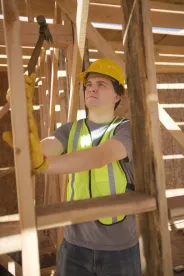Every new home—no matter if it is a single-family, townhome, duplex, co-op, condominium, or even modular home—comes with a ten year warranty as required by the New Home Warranty Program, which was enacted by the New Jersey Legislature in 1977 under the New Home Warranty and Builders’ Registration Act. While the New Home Warranty Program undoubtedly affords purchasers with an array of protections and avenues for redressing defects in newly constructed homes, it is not without pitfalls that the unsuspecting homeowner should be mindful of.
What does the New Home Warranty Program cover?
The first question you may be asking is: what does the New Home Warranty Program cover? The New Home Warranty Program is a ten-year phased warranty, which covers everything from grading to major structural defects. The availability of coverage for specific defects is directly tied to the warranty year. This means that during the first year of the program the warranty is at the peak of its protections, which diminish over time.
The first year of the warranty covers nearly all defects in workmanship or materials, including, but not limited to, concrete, masonry, stucco and cement plaster, carpentry and finished carpentry, waterproofing, insulation, siding, roofing, doors and windows, mechanical and electrical system defects, and major structural defects. After the first year of the warranty, the available coverage becomes more limited.
The second year of the warranty is limited to mechanical and electrical system defects and major structural defects. Years three through ten of the warranty are strictly limited to “major structural defects,” which is defined to mean “any actual damage to the load-bearing portion of the home, including consequential damages, damage due to subsidence, expansion or lateral movement of the soil (excluding movement caused by flood or earthquake) that affects its load-bearing function and that vitally affects or is imminently likely to vitally affect use of the home for residential purposes.”
Be Aware of the Election of Remedies Provision
Sounds great, right? Not so fast. Before you begin the process of filing your claim under the New Home Warranty Program there is one key aspect that you must be aware of, which is the election of remedies provision of the program. The New Home Warranty Program presents homeowners facing issues with their newly constructed home a strategic dilemma: file a claim under the New Home Warranty Program or file a lawsuit with the courts. The adage “when one door closes, another opens” does not apply here, at least with respect to the same defect. Once a homeowner elects a remedy, whether it be bringing suit against the builder or filing a claim under the New Home Warranty Program, the homeowner is bound to that decision and will be barred from changing course.
The election of remedies provision of the New Home Warranty Program is so stringent that under the applicable regulations the mere initiation of a claim under the New Home Warranty Program, i.e. simply submitting the initial paperwork, will bar a homeowner from turning to the courts for redress related to any defect submitted as a claim under the program.
For instance, Mr. and Mrs. Smith purchase a newly constructed home in New Jersey. During the first two years in their new home, life is great and Mr. and Mrs. Smith are not aware of any workmanship issues. However, during year three they notice water stains have appeared in their living room ceiling. Without knowing too much about the New Home Warranty Program, Mr. Smith says, “Not to worry, our home came with a ten year warranty. We’ll file a claim and get it fixed.” And so, Mr. Smith fills out the necessary paperwork and submits a claim under the New Home Warranty relating to the water leak. Several weeks later Mr. Smith receives a letter in the mail informing him that the claim is not covered as the home is in the third year of the warranty program, which covers only major structural defects and therefore the claim is denied. Can the Smiths now bring a lawsuit against the builder for the water leak? Unfortunately, the answer is they cannot and they now have no recourse for that defect.



 />i
/>i
